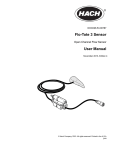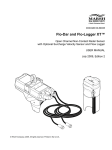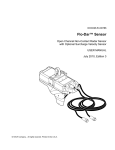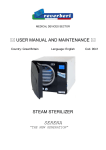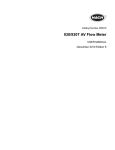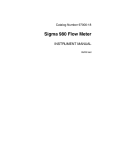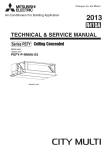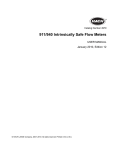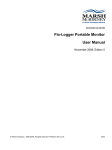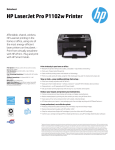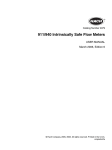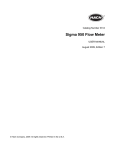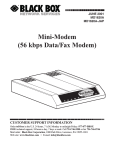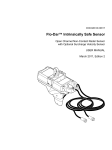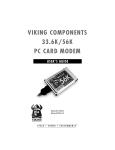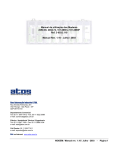Download Sigma 910/920 User Manual
Transcript
Catalog Number 4975 Sigma Flow Meter Models 910 & 920 USER MANUAL November 2008 Edition 11 © Hach Company, 2002, 2003, 2005, 2008. All rights reserved. Printed in the U.S.A. te 11/08 11 ed Visit http: //www.hach.com Table of Contents Section 1 Specifications ............................................................................................................................................... 5 Section 2 General Information ..................................................................................................................................... 7 2.1 Safety Information ..................................................................................................................................................... 7 2.1.1 Use of Hazard Information ............................................................................................................................... 7 2.1.2 Precautionary Labels ....................................................................................................................................... 7 2.1.3 Hazardous Locations ....................................................................................................................................... 8 2.1.4 Confined Space Entry ...................................................................................................................................... 8 2.1.5 FCC Requirements .......................................................................................................................................... 9 2.1.6 Equipment Attachment Limitations................................................................................................................... 9 2.2 Items Required for Installing and Using the Flow Meter.......................................................................................... 10 2.3 Optional Accessories for Use with the Flow Meter .................................................................................................. 10 2.4 Planning for Success: Considerations for Installing Your Flow Meter ......................................................................11 2.4.1 Choosing the Proper Site ................................................................................................................................11 2.4.2 Dealing with Difficult Sites...............................................................................................................................11 2.4.3 Using the Proper Batteries ..............................................................................................................................11 2.4.4 Mounting the Flow Meter with the Proper Orientation.....................................................................................11 2.4.5 Preventing Damage to the Flow Meter in a Harsh Environment .....................................................................11 2.5 Choosing the Appropriate Meter and Sensor Combination ......................................................................................11 2.5.1 Types of Sensors ........................................................................................................................................... 12 Section 3 Software and Communications ................................................................................................................. 13 3.1 Required Software................................................................................................................................................... 13 3.2 Programming and Analysis Options ........................................................................................................................ 13 3.3 RS232 Serial Port (All Models)................................................................................................................................ 13 3.4 Modem Communications (Model 920 Only) ............................................................................................................ 15 3.5 Sampler Receptacle (Model 920 Only).................................................................................................................... 15 3.5.1 Sampler Receptacle Pin Descriptions............................................................................................................ 15 3.5.2 Logging Sample Information in the 920 Flow Meter from a Hach Sampler.................................................... 16 Section 4 Channel Installation Options ..................................................................................................................... 17 Section 5 Meter Installation ........................................................................................................................................ 19 5.1 Installing and Replacing the Batteries ..................................................................................................................... 19 5.1.1 Battery-Life Estimates .................................................................................................................................... 20 5.2 Mounting the Flow Meter ......................................................................................................................................... 20 5.3 Connecting Sensors to the Flow Meter ................................................................................................................... 22 5.3.1 Ultrasonic Level Sensor ................................................................................................................................. 22 5.3.2 Level/Velocity Sensor..................................................................................................................................... 22 5.3.3 Rain Gauge .................................................................................................................................................... 23 Section 6 Maintenance................................................................................................................................................ 25 6.1 General Maintenance .............................................................................................................................................. 25 6.1.1 Cleaning the Flow Meter ................................................................................................................................ 25 6.1.2 Storing the Flow Meter ................................................................................................................................... 25 6.1.3 Maintaining the O-Ring Gasket on the End Cap ............................................................................................ 25 6.1.4 Electronics Compartment Maintenance ......................................................................................................... 25 6.1.4.1 Fuses.................................................................................................................................................... 25 6.1.4.2 Memory Batteries ................................................................................................................................. 25 6.2 Desiccant Maintenance ........................................................................................................................................... 26 6.2.1 Reusing Desiccant ......................................................................................................................................... 26 6.2.2 Replacing the Sensor Desiccant .................................................................................................................... 26 Table of Contents Page 3 Table of Contents 6.2.3 Replacing the Battery and Electronics Compartment Desiccant ....................................................................26 6.3 Sensor Calibration ...................................................................................................................................................27 6.3.1 Velocity Sensor Calibration.............................................................................................................................27 6.3.2 Zeroing the Sensor .........................................................................................................................................27 6.3.3 Important Guidelines for Sensor Installation...................................................................................................27 6.3.3.1 Proper Strain Relief of Sensor Cable ....................................................................................................28 6.3.4 Connecting the Sensor to the Mounting Bands ..............................................................................................28 6.3.5 Placing the Sensor and Mounting Band into the Pipe ....................................................................................29 6.3.6 Compensating for Velocity Direction...............................................................................................................30 6.3.7 Performing a Level Adjustment ......................................................................................................................31 6.4 Sensor Maintenance ................................................................................................................................................31 6.4.1 Cleaning the Sensor (Oil-filled and Standard) ................................................................................................31 6.4.1.1 Cleaning the Sensor (Oil-filled and Non-oil)..........................................................................................32 6.4.2 Oil Replenishment (Oil Kit Cat. No. 7724800) ................................................................................................34 6.4.3 Changing the Sensor Desiccant .....................................................................................................................35 6.4.3.1 Desiccant Replacement Procedure.......................................................................................................35 6.4.4 Hydrophobic Filter Description .......................................................................................................................36 6.4.5 Hydrophobic Filter Replacement Procedure...................................................................................................36 Section 7 Replacement Parts and Accessories ........................................................................................................39 Section 8 Contact Information for U.S.A. and Outside Europe................................................................................43 Appendix A Exploded View Drawings.......................................................................................................................47 Table of Contents Page 4 Section 1 Specifications Specifications are subject to change without notice. Model 910 Dimensions 11.4 cm dia. x 44.8 cm L (4.5" dia. x 17.625" L) Weight 3.54 kg (7.8 lb) with batteries Enclosure Material PVC Enclosure Rating NEMA 6P (IP67) Operating Temperature Range –18 to 60 °C (0 to 140 °F) Storage Temperature Range – 40 to 60 °C (– 40 to 140 °F) Power Source One Energizer EN-529, Alkaline, 6 V dc battery Battery Life 60 days typical, with a 15-minute recording interval, one level and one velocity, one data download per week, at 10 °C (50 °F) (also affected by site conditions) User Interface PC Monitoring Intervals 1, 2, 3, 5, 6, 10, 12, 15, 20, 30, 60 minutes Program Memory Non-volatile, programmable flash, can be updated via RS232 port Time-Based Accuracy ± 1 second per day Level: in., m, cm, ft Units of Measurement Flow: gps, gpm, gph, lps, lpm, lph, mgd, afd, cfs, cfm, cfh, cfd, m3s, m3m, m3h, m3d Totalized Flow: gal., ft³, acre-ft., L, m³ Capacity: 90 days of one level reading and one velocity reading at 15-minute recording intervals Data Storage Data Types: Level and velocity Storage Mode: Wrap or slate RAM Memory: 128K Communications Serial connection to IBM compatible computer with Hach analysis software Method: Doppler ultrasonic Transducer Type: Twin 1 MHz piezoelectric crystals Typical minimum depth for velocity: 2 cm (0.8 in.) Velocity Measurement Accuracy Range: –1.52 to 6.10 m/s (–5 to 20 fps) Zero Stability: 0.015 m/s (<0.05 fps) Accuracy: ± 2% of reading Operating Temperature: –18 to 60 °C (0 to 140 °F) Specifications Page 5 Specifications Model 920 Dimensions 16.8 cm dia. x 44.7 cm L (6.625" dia. x 17.625" L) Weight 7.5 kg (16.5 lb) with batteries Enclosure Material PVC Enclosure Rating NEMA 6P (IP67) Operating Temperature Range –18 to 60 °C (0 to 140 °F) Storage Temperature Range –40 to 60 °C (–40 to 140 °F) Power Source Two Energizer EN-529, Alkaline, 6 V dc batteries Battery Life 90 days typical, with a 15-minute recording interval, one level and one velocity, one data download per week, at 10 °C (50 °F) (also affected by site conditions) User Interface PC Monitoring Intervals 1, 2, 3, 5, 6, 10, 12, 15, 20, 30, 60 minutes Program Memory Non-volatile, programmable flash, can be updated via RS232 port Time-Based Accuracy ± 1 second per day Level: in., m, cm, ft Units of Measurement Flow: gps, gpm, gph, lps, lpm, lph, mgd, afd, cfs, cfm, cfh, cfd, m3s, m3m, m3h, m3d Totalized Flow: gal., ft³, acre-ft., L, m³ Capacity: 240 days of two level readings and two velocity readings at a 15-minute recording intervals Data Storage Data Types: Level, velocity, and rainfall Storage Mode: Wrap or slate RAM Memory: 128K Communications Serial connection to IBM compatible computer with Hach analysis software Modem 14400, V.32 bis,V.42, MNP2-4 error correction. V.42 bis, MNP5 data compression. MNP10EC Cellular Protocol Local Terminal RS232 at 19.2k baud Method: Doppler ultrasonic Transducer Type: Twin 1 MHz piezoelectric crystals Typical minimum depth for velocity: 2 cm (0.8 in.) Velocity Measurement Accuracy Range: –1.52 to 6.10 m/s (–5 to 20 fps) Zero Stability: 0.015 m/s (<0.05 fps) Accuracy: ± 2% of reading Operating Temperature: –18 to 60 °C (0 to 140 °F) Specifications Page 6 Section 2 General Information 2.1 Safety Information Please read this entire manual before unpacking, setting up, or operating this instrument. Pay particular attention to all danger and caution statements. Failure to do so could result in serious injury to the operator or damage to the equipment. To ensure the protection provided by this equipment is not impaired, do not use or install this equipment in any manner other than that which is specified in this manual. 2.1.1 Use of Hazard Information If multiple hazards exist, this manual will use the signal word (Danger, Caution, Note) corresponding to the greatest hazard. DANGER Indicates a potentially or imminently hazardous situation which, if not avoided, could result in death or serious injury. CAUTION Indicates a potentially hazardous situation that may result in minor or moderate injury. NOTE Information that requires special emphasis. 2.1.2 Precautionary Labels Read all labels and tags attached to the instrument. Personal injury or damage to the instrument could occur if not observed. This symbol, if noted on the instrument, references the instruction manual for operation and/or safety information. Electrical equipment marked with this symbol may not be disposed of in European public disposal systems after 12 August of 2005. In conformity with European local and national regulations (EU Directive 2002/96/EC), European electrical equipment users must now return old or end-of life equipment to the Producer for disposal at no charge to the user. Note: For return for recycling, please contact the equipment producer or supplier for instructions on how to return end-of-life equipment, producer-supplied electrical accessories, and all auxiliary items for proper disposal. This symbol, when noted on a product enclosure or barrier, indicates that a risk of electrical shock and/or electrocution exists and indicates that only individuals qualified to work with hazardous voltages should open the enclosure or remove the barrier. This symbol, when noted on the product, identifies the location of a fuse or current limiting device. This symbol, when noted on the product, indicates the presence of devices sensitive to Electro-static Discharge and indicates that care must be taken to prevent damage to them. This symbol, when noted on the product, identifies a risk of chemical harm and indicates that only individuals qualified and trained to work with chemicals should handle chemicals or perform maintenance on chemical delivery systems associated with the equipment. This symbol, if noted on the product, indicates the need for protective eye wear. This symbol, when noted on the product, identifies the location of the connection for Protective Earth (ground). General Information Page 7 General Information 2.1.3 Hazardous Locations The 910 and 920 Flow Meters are not approved for use in hazardous locations as defined in the National Electrical Code. DANGER Although some Hach products are designed and certified for installation in hazardous locations as defined by the National Electrical Code, many Hach products are not suitable for use in hazardous locations. It is the responsibility of the individuals who are installing the products in hazardous locations to determine the acceptability of the product for the environment. Additionally, to ensure safety, the installation of instrumentation in hazardous locations must be per the manufacturer's control drawing specifications. Any modification to the instrumentation or the installation is not recommended and may result in life threatening injury and/or damage to facilities. 2.1.4 Confined Space Entry The following information is provided to guide users of 950 Flow Meters on the dangers and risks associated with entry into confined spaces. DANGER Additional training in Pre-Entry Testing, Ventilation, Entry Procedures, Evacuation/Rescue Procedures and Safety Work Practices is necessary to ensure against the loss of life in confined spaces. On April 15, 1993, OSHA's final ruling on CFR 1910.146, Permit Required Confined Spaces, became law. This standard directly affects more than 250,000 industrial sites in the United States and was created to protect the health and safety of workers in confined spaces. Definition of Confined Space A Confined Space is any location or enclosure that presents or has the immediate potential to present one or more of the following conditions: • An atmosphere with less than 19.5% or greater than 23.5% oxygen and/or more than 10 ppm Hydrogen Sulfide (H2S). • An atmosphere that may be flammable or explosive due to gases, vapors, mists, dusts, or fibers. • Toxic materials which upon contact or inhalation, could result in injury, impairment of health, or death. Confined spaces are not designed for human occupancy. They have restricted entry and contain known or potential hazards. Examples of confined spaces include manholes, stacks, pipes, vats, switch vaults, and other similar locations. Standard safety procedures must always be followed prior to entry into confined spaces and/or locations where hazardous gases, vapors, mists, dusts, or fibers may be present. Before entering any confined space check with your employer for procedures related to confined space entry. Safety Information Page 8 General Information 2.1.5 FCC Requirements 1. The Federal Communications Commission (FCC) has established Rules which permit this device to be directly connected to the telephone network. Standardized jacks are used for these connections. This equipment should not be used on party lines or coin lines. 2. If this device is malfunctioning, it may also be causing harm to the telephone network; this device should be disconnected until the source of the problem can be determined and until repair has been made. If this is not done, the telephone company may temporarily disconnect service. 3. The telephone company may make changes in its technical operations and procedures; if such changes affect the compatibility or use of this device, the telephone company is required to give adequate notice of the changes. 4. If the telephone company requests information on what equipment is connected to their lines, inform them of: a. The telephone number that this unit is connected to, b. The ringer equivalence number [1.4B] c. The USOC jack required [RJ11C], and d. The FCC Registration Number Items (b) and (d) are indicated on the label. The ringer equivalence number (REN) is used to determine how many devices can be connected to your telephone line. In most areas, the sum of the RENs of all devices on any one line should not exceed five. If too many devices are attached, they may not ring properly. 2.1.6 Equipment Attachment Limitations Notice: The Canadian Industry Canada label identifies certified equipment. This certification means that the equipment meets certain telecommunications network protective, operational and safety requirements. The Department does not guarantee the equipment will operate to the user's satisfaction. Before installing this equipment, users should ensure that it is permissible to be connected to the facilities of the local telecommunications company. The equipment must also be installed using an acceptable method of connection. In some cases, the company's inside wiring associated with a single line individual service may be extended by means of a certified connector assembly (telephone extension cord). The customer should be aware that compliance with the above conditions may not prevent degradation of service in some situations. Repairs to certified equipment should be made by an authorized Canadian maintenance facility designated by the supplier. Any repairs or alterations made by the user to this equipment, or equipment malfunctions, may give the telecommunications company cause to request the user to disconnect the equipment. Users should ensure for their own protection that the electrical ground connections of the power utility, telephone lines and internal metallic water pipe system, if present, are connected together. This precaution may be particularly important in rural areas. CAUTION Users should not attempt to make such connections themselves, but should contact the appropriate electric inspection authority, or electrician, as appropriate. Safety Information Page 9 General Information The Load Number (LN) assigned to each terminal device denotes the percentage of the total load to be connected to a telephone loop which is used by the device, to prevent overloading. The termination on a loop may consist of any combination of devices subject only to the requirement that the total of the Load Numbers of all the devices does not exceed 100. 2.2 Items Required for Installing and Using the Flow Meter Batteries Use only Energizer EN-529, Alkaline, 6 V dc batteries (Cat. No. 3667). Battery Compartment Desiccant Use a desiccant cartridge to avoid moisture damage to the batteries and electronics. See Desiccant Maintenance on page 26 for more information. Level and Velocity Sensors Select the level or velocity sensors that best suit your application. For more information, see Choosing the Appropriate Meter and Sensor Combination on page 11. Mounting Apparatus Select the appropriate Logger and Sensor mounting apparatus from Replacement Parts and Accessories on page 39. Programming and Data Retrieval Software These flow meters require the use of InSight® or Vision®, a high-end, integrated sewer system management application. InSight is recommended for small- to medium-sized flow studies. For broader applications, Vision supports automated data collection with an unlimited number of sensors. See Software and Communications on page 13 for more information. 2.3 Optional Accessories for Use with the Flow Meter Rain Gauge Connect your flow meter to the Hach tipping bucket rain gauge to record rainfall. See Rain Gauge on page 23 for more information. Wastewater Sampler Connect an optional Hach wastewater sampler to the flow meter. Models 920 and 930 can set the pace for an external sampler in proportion to flow. In storm water applications, these models can trigger the sampler in response to water level or rainfall. Safety Information Page 10 General Information 2.4 Planning for Success: Considerations for Installing Your Flow Meter 2.4.1 Choosing the Proper Site The accuracy of flow measurements greatly depends on the suitability of the monitoring site. Select sites that have normalized flow and minimal turbulence. Turbulence can make it difficult to detect an average velocity in the flow stream. Obstructions, vertical drops, pipe bends, and elbows can create turbulence and affect the accuracy of your measurements. Table 1 contains suggestions for preventing turbulence. Table 1 Suggestions for Preventing Turbulence Site Condition Suggested Remedy Outfalls Attach the sensor at least ten times the maximum expected level upstream of the outfall. Vertical drops in the channel floor Attach the sensor at least ten times the maximum expected level upstream of the vertical drop. Elbows, sharp turns, and “Y” connections Locate the sensor at least ten times the maximum expected level upstream of the impediment. Attach the sensor at least ten times the maximum expected level downstream of the vertical drop. Locate the sensor at least ten times the maximum expected level downstream of the impediment. 2.4.2 Dealing with Difficult Sites Some sites may be difficult to monitor due to poor site conditions. The direction and the speed of the particles in the flow stream contribute to the signal received by the velocity sensor. If turbulence near the measurement point is excessive, it may be difficult for the sensor to determine the average velocity of the stream. Hach loggers provide several unique features to help deal with these problem sites. See Compensating for Velocity Direction in your sensor manual. 2.4.3 Using the Proper Batteries Use only Energizer EN-529, Alkaline, 6 V dc batteries. These batteries are required to achieve the rated performance of the flow meter. Other batteries will produce unacceptable results. See Installing and Replacing the Batteries on page 19 for more information. 2.4.4 Mounting the Flow Meter with the Proper Orientation You must mount the flow meter so that the connectors face down. The end of the meter that contains the batteries should face up. If the connectors face up, they may corrode and allow water to seep into the instrument. 2.4.5 Preventing Damage to the Flow Meter in a Harsh Environment The connectors on your flow meter have protective caps. Cover the connectors with the protective caps when not in use to prevent corrosion. 2.5 Choosing the Appropriate Meter and Sensor Combination Use Table 2 to determine which sensors to use. Table 2 Flow Meter and Sensor Configuration Options Flow Meter Model Level and Velocity Sensor Configuration Options 910 Meter plus one Submerged Depth/Velocity Sensor or one Velocity Only Sensor 920 Meter plus two Submerged Depth/Velocity Sensors or Meter plus one Submerged Depth/Velocity Sensor and one Ultrasonic 75 kHz Sensor Safety Information Page 11 General Information 2.5.1 Types of Sensors Submerged Depth/Velocity Sensors Submerged Depth/Velocity sensors can measure level and velocity simultaneously. A submerged pressure transducer measures level. Velocity is measured with sound waves, using the Doppler principle. Wafer Velocity Sensor The Wafer Velocity Sensor (Cat. No. 88005 or 88006) is an extremely low-profile velocity sensor. It does not measure level. The streamlined shape of the wafer probe allows velocity measurement in very low-flow conditions. When used in conjunction with a level sensor (such as the In-Pipe Ultrasonic Level Sensor), you can calculate flow. In-Pipe Ultrasonic Sensor Use the In-Pipe Ultrasonic Level Sensor (Cat. No. 3702-01 or 3702-02) in pipes where level measurement to the top of the pipe is desired. This sensor has no effective deadband and will read the level until liquid reaches the bottom of the sensor housing. The entire deadband is contained horizontally within the sensor body. Ultrasonic Sensor (Downlook) Downlook ultrasonic sensors are available with different beam angles, beam spread, and deadbands. Use the 75 KHz sensor with the 920 Flow Meter. Safety Information Page 12 Section 3 Software and Communications 3.1 Required Software You can program or retrieve data from your flow meter via modem, DTU II, or direct connection to the RS232 serial port using a PC and one of the following software packages: • InSight® Data Analysis Software is a Microsoft Windows® program for small- to medium-sized flow monitoring jobs. • Vision® Integrated Sewer System Management Software provides high-end, automated data collection and automated batch report processing, using an unlimited number of meters. Vision is a Microsoft Windows® program. 3.2 Programming and Analysis Options • Built-in flow equations • Pager activation upon alarm condition • 2-way modem and serial communications • Storage of 116,000 data points in battery-backed RAM Memory • Storm water sampling trigger • Rainfall measurement • Flow proportional sampler output • High, low, rate of change and trouble alarms • For details on programming your flow meter, refer to your software manual. 3.3 RS232 Serial Port (All Models) The high speed RS232 serial port communicates with a PC or Data Transfer Unit (DTU) at speeds from 1200 to 19,200 baud as shown in Figure 1. The optional extension cable (Cat. No. 3358) includes a built-in ladder hook and is designed to connect to a cable (Cat. No. 1727) near the surface for easy reach in manholes. See Figure 1. Software and Communications Page 13 Software and Communications Figure 1 Communications with the Flow Meter, DTU, and PC 4 3 5 1 2 1. Flow Meter 4. DTU II Connection Cable 2. RS232 Cable 5. Personal Computer 3. DTU II Figure 2 Serial Port Pins A B F C E D Pin Letter Description Wire Color A B+ (used to power DTU) White B Ground Blue C DSR Yellow D RCD Black E DTR Red F TXD Green RS232 Serial Port (All Models) Page 14 Software and Communications 3.4 Modem Communications (Model 920 Only) CAUTION Use care when making modem connections as high voltage may be present on the phone wires! The 920 Flow Meter can be configured with a 14,400 baud, cellular capable internal telephone modem (Cat. No. 4872). These advanced, very low power modems let you communicate with Hach loggers over long distances using public telephone lines or a cellular phone. The 920 Flow Meter modems communicate at speeds from 300 to 14,400 baud. Connect the red and green wires from the logger modem connector to the red and green wires provided by the telephone company. Figure 3 Modem Receptacle Pins A B Pin Letter Designation Wire Color Description A Tip Green Ground B Ring Red Signal 3.5 Sampler Receptacle (Model 920 Only) 3.5.1 Sampler Receptacle Pin Descriptions The optional “sampler” port lets you connect Model 920 or 930 to a Hach wastewater sampler. This option provides several features: • Flow proportional sampling • Stormwater trigger, based on level and/or rate of rainfall. Useful for the USEPA NPDES permitting program • Sample history logging Modem Communications (Model 920 Only) Page 15 Software and Communications Table 3Sampler Receptacle Pin Description Pin Letter Wire Color A White Not used. B Ground Blue Provides the ground line that is used in conjunction with the other signals on this connector. C Flow Pulse Output Yellow Used in conjunction with Pin B (ground) to tell a sampler that a pre-determined amount of flow has accumulated. Rating: +8 V dc. Output current is 100 mA dc (max.) with a duration of 500 ms. D Sampler Start Black Used to “wake up” a wastewater sampler when a level and/or rainfall set-point condition is met so that it can begin sampling. Used in conjunction with Pin B (ground), this line is normally allowed to float and is switched to ground (by transistor) once the set-point conditions are met. Rating: +24 V dc (max.) E Event Input Red This signal is received from a Hach wastewater sampler. It confirms that a sample has been collected. The time and date of each water sample appears on the data printout when downloaded using a Data Transfer Unit or Hach PC software. Rating: +12 V dc (max.) minimum 3 sec. pulse. F Bottle Number Input Green Description This signal is received from a Hach wastewater sampler. It is used in conjunction with the “Event Input” signal described above. It tells the flow meter which bottle was used and when a sample was taken. This information will appear in the data printout (see “Sample Times and Dates”) when downloaded using a Data Transfer Unit or Hach Support Software. Bottle Number signal description If the Program Complete Output (pin F of the aux. connector) is disabled on the sampler, then it is used to transmit the bottle number to the connected device. Time A = 200 msec Time B = 100 msec (50 ms HI 50 ms LO) Note: If a sample attempt fails, the first pulse width 'B' is 150 msec HI and 50 msec LO. Note: If Sample Distribution is programmed for multiple bottles per sample mode, only the first bottle number of the set is transmitted via pin-F. Cable Required Multi-Purpose Half Cable Assembly (Cat. No. 941): 3 m (10') long, 6-pin connector on one end, tinned wire leads on the other end. For use with non-Hach samplers. or Multi-Purpose Full Cable Assembly (Cat. No. 940): 3 m (10') long, 6-pin connector on both ends. Custom sizes: 7.6 m lengths (25 ft.) and custom sizes are also available. 3.5.2 Logging Sample Information in the 920 Flow Meter from a Hach Sampler 1. Connect the appropriate cable (Cat. No. 940 or 540) to the “Sampler” receptacle on the flow meter and the “Auxiliary” receptacle on the sampler. 2. Program the sampler for Special Output/Sample Output. See the appropriate sampler manual for details. Sampler Receptacle (Model 920 Only) Page 16 Section 4 Channel Installation Options Figures 4 through 7 show how to install the 910 and 920 for various applications. Models 910 and 920 do not require profiling to establish average velocity, allowing setup in a dry channel (Figure 4). Rapid signal processing and temperature compensation accurately record the change from dry to wet conditions. Figure 4 Installation Setup in a Dry Channel When a Combined Sewer Overflow (CSO) is conducive to accurate flow measurement, a Model 920 can measure depth and velocity in the primary channel and measure discharge in the overflow channel with ±5% accuracy. See Figure 5. Figure 5 Installation for Combined Sewer Overflow (CSO) Applications Channel Installation Options Page 17 Channel Installation Options In some instances, the overflow in some CSO applications may be too turbulent for accurate measurement. Figure 6 shows Model 920 with two depth/velocity probes that will measure flow upstream and downstream of the outfall to determine the volume and duration of the overflow. Figure 6 Installation for Combined Sewer Overflow (CSO) Applications with Turbulence in the Overflow Custody transfer or interagency billing demand redundant measurement for chain of custody. In Figure 7, one Model 920 provides ultrasonic measurement of flow in a Parshall flume while also measuring flow upstream using the Continuity Equation (Q=AV). This ensures no loss of data in a submerged flow condition. Figure 7 Installation for Custody Transfer or a Billing Arrangement Channel Installation Options Page 18 Section 5 5.1 Meter Installation Installing and Replacing the Batteries CAUTION Use only alkaline batteries in this product. Other types of batteries can result in safety hazards. Use only Energizer®* EN-529, alkaline, 6 V dc batteries. These batteries are required to achieve the rated performance of the flow meter. Other batteries will produce unacceptable results. Nonalkaline or non-industrial grade batteries will damage the battery compartment and may void the warranty. Energizer EN-529 batteries are readily available and provide sufficient power to operate the flow meter for extended periods. Use this model battery to obtain the rated operating duration and to safeguard the logger circuitry. Replacement batteries are available from Hach (Cat. No. 3667). Note: Do not soil or damage the two rubber O-rings on the end cap while removing or replacing the end cap. The O-rings provide a watertight seal for the battery compartment. Replace them if they are lost or damaged. The 910 uses one 6 V dc alkaline battery and the 920 uses two 6 V dc alkaline batteries. Install the fresh battery(s) into the battery compartment, terminal-end first. It does not matter which way the battery is rotated when it is inserted. The battery holder will accept the batteries regardless of polarity. Use two fresh batteries each time in 920. Do not mix fresh batteries with used ones. Grasp the logger by the handle opposite of the interface connectors and twist that end counterclockwise to open. Unscrew the end cap. Figure 8 Battery Pack Compartment 1 Eveready Energizer EN 529 Alkaline Eveready Energizer EN 529 Alkaline 2 3 1. Loosen to remove batteries (after removing the battery pack). 2. Loosen to remove the battery pack from the meter. 3. Remove power cable. *Energizer is a registered trademark of Eveready Battery Company, Inc. Meter Installation Page 19 Meter Installation 5.1.1 Battery-Life Estimates When using Energizer EN-529, alkaline, 6 V dc batteries, battery life is based on: • Number of sensors installed • Recording intervals (longer intervals increase battery life) • Number of channels logged in memory • Temperature (colder temperatures decrease battery life) • Site hydraulics (second order effect caused by excessive turbulence) The chart below provides typical expected battery life for each logger model: Table 4 Estimated Battery Life Model Battery Life in Days 910 60 920 90 You can access a real-time battery voltage check via InSight® software. Select the 'Current Status' display. The chart below shows the estimated dc voltage readings when approximately 30 days of battery life remain. Table 5 Battery Voltage when a 30-Day Battery Capacity Remains 5.2 Model Battery Voltage (dc) 910 3.8 920 9.0 Mounting the Flow Meter Important Note: Before using the flow meter, insert the port/vent plug into the top hole of the unit with a 7/16” wrench. DANGER Not for use in hazardous locations where combustible gases may be present. When mounting the flow meter, remember to: • Mount the meter so that the connectors face down. The end of the meter that contains the batteries should face up. If the connectors face up, they may corrode and allow water to seep into the instrument. See Figure 9. • When not in use, cover the connectors with their protective caps to prevent corrosion. Use the appropriate manhole support bracket/spanner bar. See Replacement Parts and Accessories on page 39. Mounting the Flow Meter Page 20 Meter Installation Figure 9 Installation Options 1 2 3 4 1. Instrument Support Bracket (Cat. No. 5713000) 3. Suspension Harness (Cat. No. 4920) 2. Manhole Cover 4. Wall/Ladder Mount Suspension Bracket (Cat. No. 4874) Mounting the Flow Meter Page 21 Meter Installation 5.3 Connecting Sensors to the Flow Meter 5.3.1 Ultrasonic Level Sensor One 75 kHz Ultrasonic Sensor can be attached to each 'U-SONIC' receptacle. Loggers that use more than one ultrasonic sensor have ultrasonic receptacles labeled 'U-SONIC A', 'U-SONIC B', etc. Each sensor may be assigned in the software as the primary sensor or as one or more secondary sensors. The primary sensor is used for all flow calculations in InSight software. Vision® software allows the use of any sensor in flow calculation. Figure 10 describes the pins on all of the sensor receptacles. Figure 10 Ultrasonic Sensor Receptacle Pins D A C B Pin Letter Description Wire Color A Temperature(+) Red B Temperature (-) Black C Ultrasonic (+) Shield D Ultrasonic (-) Clear 5.3.2 Level/Velocity Sensor Velocity receptacles A, B, and C accept Submerged Area/Velocity sensors, Velocity-Only probes, or any combination of the two. Figure 11 describes the pins on all of the velocity receptacles. Connecting Sensors to the Flow Meter Page 22 Meter Installation Figure 11 Velocity Receptacle Pins B A H C J K G D E F Pin Letter Description Wire Color A +12 V dc Red B Ground Green C Velocity receive (ground) B/W shield D Velocity receive (+) B/W center E Velocity transmit (ground) Black shield F Velocity transmit (+) Black center G Depth (-) Black H Depth (+) White Not used NA J K 5.3.3 Rain Gauge An optional Hach tipping bucket rain gauge may be connected to the 'RAIN GA.' connector of Model 920 flow meter. Each tip of the bucket in the rain gauge transmits a dry contact closure to the flow meter. Each dry contact closure represents 0.01" (0.0254 cm) of rainfall. A constant dc voltage is supplied on Pin C of the rain gauge receptacle. The dry contact closure in the rain gauge returns a voltage pulse into Pin A with each tip. Figure 12 describes the pins on all of the rain gauge receptacles. Figure 12 Rain Gauge Receptacle Pins A B F E C D Pin Letter* Description A Tip Signal / 0.01" (2.54 cm) of rainfall C Source Voltage *. Pins B, D, E and F are not used in the rain gauge connector. Connecting Sensors to the Flow Meter Page 23 Visit us at www.hach.com Section 6 Maintenance DANGER Only qualified personnel should conduct the maintenance task described in this section of the manual. 6.1 General Maintenance 6.1.1 Cleaning the Flow Meter Clean the outside of the logger case with warm water and mild detergent. Do not use solvents or harsh cleaners to clean the logger. Do not use high pressure washing equipment to clean the case. 6.1.2 Storing the Flow Meter Remove the 6 volt alkaline batteries from the logger when storing for long periods (more than 3 months). Store the sensors in a dry area. Make sure that all desiccant materials in the probes are kept fresh (blue) at all times. 6.1.3 Maintaining the O-Ring Gasket on the End Cap Note: Do not use petroleum jelly to lubricate the O-rings. Two O-ring gaskets are installed in each end cap of the flow meter. They maintain the water tight seal on the flow meter. Use care when the end caps are removed—do not soil, cut, or nick the gaskets. Replace them immediately if any physical damage is apparent. A light coating of O-ring lubricant is sufficient to maintain a water-tight seal. Table 6lists replacement O-ring gaskets. Table 6Replacement O-rings Description Part Number Model 910 End Cap O-ring 4912 Model 920 End Cap O-ring 4863 6.1.4 Electronics Compartment Maintenance Important Note: The electronics compartment is only serviceable by a qualified electronics technician familiar with static sensitive CMOS components. Permanent damage to electronic circuitry may result from improper handling. Always wear a wrist grounding strap when handling CMOS electronic components. To open the electronics compartment, remove the four pins that hold the electronics compartment end cap in place. The pins are located under a protective tape on the outside surface of the logger near the end cap. The end cap pulls straight off after all pins are removed. 6.1.4.1 Fuses All internal fuses are self-resetting and require no maintenance. There are no other user-serviceable components inside the electronics compartment 6.1.4.2 Memory Batteries An internal battery pack that contains two, 1.5 V dc alkaline “C” batteries powers RAM memory, the real time clock, and associated circuitry. The batteries also prevent the loss of programmed settings and logged data if the main power fails or is removed. Maintenance Page 25 Maintenance The memory batteries are located inside the electronics compartment. The two cells will provide many years of trouble-free operation. Use only alkaline replacement batteries. You can set a low memory battery indicator using InSight® or Vision® Software. See the software manual for details. 6.2 Desiccant Maintenance 6.2.1 Reusing Desiccant The desiccant material is a silica gel indicator. When the gel is saturated with moisture, the beads turn from blue to pink. To rejuvenate the beads for reuse, remove them from the assembly. Heat the beads in an oven at 100 to 180 °C (212 to 350 °F) until the beads turn blue again. Discard and replace the beads if they do not turn blue after heating. 6.2.2 Replacing the Sensor Desiccant Note: Before calibrating or installing the Submerged Sensor it is absolutely essential that the red plastic protective cap be removed from the atmospheric reference port of the desiccant cartridge. The air dryer assembly is an integral part of the velocity probe cable. A small diameter tube is contained within the sensor cable to supply a reference port from the logger to the transducer in the sensor. The reference air passes through the in-line desiccant where all moisture is removed. To remove or replace the sensor desiccant: 1. Remove the fill plug from the assembly. 2. Remove the pink desiccant beads and allow the assembly to air dry. 3. Fill the assembly with fresh (blue) desiccant. 4. Replace the fill plug. 6.2.3 Replacing the Battery and Electronics Compartment Desiccant A small desiccant cartridge in the battery compartment prevents moisture damage to the batteries and power circuitry. The electronics compartment desiccant cartridges should be changed whenever you service the electronics (see section 6.1.4 on page 25) to assure a moisture free environment inside the enclosure. Table 7contains replacement part numbers. If the normally blue desiccant beads turn pink, replace the cartridge or remove the cartridge end cap and recharge or replace the desiccant material. See Reusing Desiccant on page 26. A small clip holds the desiccant cartridge in place. Pull the cartridge straight out of the clip to remove it. Table 7Replacement Desiccant Description Part Number Model 910 Battery Compartment Desiccant Cartridge 4933 Model 920 Battery Compartment Desiccant Cartridge 4933 Bulk Desiccant Refill (1.5 lb) 3624 Desiccant Maintenance Page 26 Maintenance 6.3 Sensor Calibration 6.3.1 Velocity Sensor Calibration The velocity sensor does not require calibration. The transmit frequency is fixed by a highly accurate quartz crystal-controlled frequency generator. 6.3.2 Zeroing the Sensor The sensor has been factory-calibrated and compensated for temperature. The sensor needs to be zeroed during each installation, but does not require calibration. The sensor should be zeroed when moving it from one flow meter or sample to another. To zero the sensor: 1. Install InSight version 5.7 or greater and start the program. 2. From the InSight software menu, select Remote Programming. 3. From the Real Time Operations list, select the level sensor to be calibrated. 4. Remove the probe from the liquid and place the sensor flat on the tabletop or floor with the sensor (the plate with the holes) facing down onto the surface. 5. Press OK on the dialog box when complete. 6.3.3 Important Guidelines for Sensor Installation • Do not install more than one sensor at a time in pipes less than 61 cm (24 inches). Multiple sensors in smaller pipes can create turbulent or accelerated flows near the sensors that may cause inaccurate measurements. • Mount the sensor as close as possible to the bottom of the pipe invert to most accurately measure low velocity levels. • Do not monitor flows in the invert of the manhole itself. The best sensor location is 3 to 5 times the sewer diameter/height upstream of the invert. • Locate monitoring sites as far from inflow junctions as possible to avoid interference caused by combined flows. • Avoid sites that contain flow obstacles within 2 to 4 pipe diameters in front of the sensor installation (rocks, stones, pipe joints, valve stems, etc.) as these will contribute to turbulence and generate high speed flows in the immediate vicinity of the obstruction. • Avoid any sites with slow moving flows that will encourage the buildup of silt in the invert or channel. Excessive silting around the sensor may inhibit the Doppler signal and decrease sensor accuracy, and may affect depth measurement accuracy. • Avoid sites with deep, rapid flows that will make it physically difficult or dangerous to install the sensor. • Avoid sites with high velocity, low-depth flows. Splash-over and excessive turbulence will be present around the sensor and data may be inaccurate. Sensor Calibration Page 27 Maintenance 6.3.3.1 Proper Strain Relief of Sensor Cable Attach the desiccant hub to the instrument handle to provide a strain relief for the sensor cable and connector (Figure 13). Figure 13 Proper Strain Relief 1. Lanyard 3. Desiccant Hub 2. Carabineer 4. Flow Meter 6.3.4 Connecting the Sensor to the Mounting Bands Important Note: If using an oil-filled sensor, replenish the oil prior to mounting the sensor to a mounting band. Refer to section 4.1.2 on page 19 for oil replenishment instructions, if applicable. 1. Attach the sensor to the spring ring. Mounting bands come with pre-drilled holes for direct mounting of the sensor to the band. 2. To reduce the likelihood of debris collecting on the cable and mounting band, route the cable along the edge of the band and fasten the cable to the mounting band with nylon wire ties (Figure 14). The cable should exit the tied area at, or near, the top of the pipe to keep it out of the flow stream. Note: If there is a large amount of silt in the bottom of the pipe, rotate the band until the sensor is out of the silt (Figure 15), assuring that the sensor remains below the minimum expected water level at all times. Silt should not be disturbed and must be measured frequently. Sensor Calibration Page 28 Maintenance Figure 14 Attaching the Sensor to the Mounting Band 4 1 3 2 1. Spring Ring 3. Screws (2) 2. Sensor 4. Nylon Wire Ties Figure 15 Avoiding Silt when Mounting the Sensor 1 4 2 3 1. Water 2. Silt 3. Pipe 4. Sensor 6.3.5 Placing the Sensor and Mounting Band into the Pipe Point the angle-face of the sensor into the flow. The manufacturer recommends placing the sensor with the arrow pointing with the flow (Figure 16). For other mounting configurations, see the appropriate flow meter manual. Slide the mounting band as far into the pipe as possible to eliminate drawdown effects near the end of the pipe. Locate the sensor at the bottom-most point in the channel. If excessive silt is present on the bottom of the pipe, rotate the band in the pipe until the sensor is out of the silt. Sensor Calibration Page 29 Maintenance Figure 16 Placing the Sensor into the Flow Manhole Velocity Sensor Normal Upstream Position Manhole Velocity Sensor Downstream Position 6.3.6 Compensating for Velocity Direction When programming the sensor the following may be selected: Option* Description Upstream Use this option at sites with fairly consistent velocities, and low to medium turbulence. The flow stream over the sensor should be relatively straight, with no drops or turns near the measurement point. (recommended for most applications) Sensor Calibration Page 30 Mount the sensor in the pipe, beveled edge facing into the flow, where the flow stream enters the measurement area (Figure 16). Maintenance Option* Description Use this option when the sensor is installed downstream of the measurement point (where the flow stream exits the site). This option is useful when more than one flow stream enters a site and the combined flow of all streams at a single exit point is measured. Mount the sensor in the downstream direction rather than the typical, upstream direction. Mounting the sensor 'backwards' in this manner (Figure 16) causes the velocity direction readings to be the opposite of actual stream flow. By selecting the Downstream choice when programming, the logger reverses the measured signal to show actual flow direction (beveled edge downstream). The maximum velocity obtained in this type of installation is 5 fps. *. Additional options may be available depending on the flow meter or sampler used. Refer to the appropriate flow meter or sampler manual for more information. Downstream 6.3.7 Performing a Level Adjustment The manufacturer recommends doing a level adjustment whenever a sensor is first installed into a flow stream. This adjustment accounts for the various physical tolerance stack-ups in the system (i.e., thickness of the mounting band, angular placement of the sensor relative to the “6 O’ clock” position in the pipe, etc.) 1. With the sensor installed in the flow, use a PC or display (950 and 980 flowmeter) to monitor Current Status. 2. Take a physical measurement of the water depth by measuring the distance from the top of the pipe to the surface of the water (item B, Figure 17), and subtracting this number from the pipe diameter (item A, Figure 17). The resulting number is the water depth (item C, Figure 17). 3. Enter the physically-measured water depth into the software using the Adjust Level function. Figure 17 Measuring the Water Level B A C 6.4 Sensor Maintenance 6.4.1 Cleaning the Sensor (Oil-filled and Standard) Clean the transducer port when: • Unexpected increase or decrease in flow or level trend occurs • Level data are missing or incorrect but velocity data are valid. • Excessive silt has deposited between the transducer and its protective cover. Sensor Maintenance Page 31 Maintenance 6.4.1.1 Cleaning the Sensor (Oil-filled and Non-oil) Important Note: Do NOT interchange an oil-filled protective cover plate with a non-oil cover plate. This will adversely affect level readings. It is possible to convert one type of sensor to the other using the Oil Probe Conversion Kit (Cat. No. 7730000), refer to the Oil Probe Conversion Kit Instruction Sheet, Cat. No. 7730089 for more information. Important Note: When cleaning the transducer, use the most gentle technique possible. Do not use sharp or pointed objects to remove sediment from the face of the transducer. If you nick or dent the transducer, it will break! 1. Soak the sensor in soapy water Note: Do not soak the sensor in bleach. Bleach will permanently damage the sensor. Refer to Table 8 for acceptable cleaning solutions. Table 8 Cleaning Solutions Acceptable Unacceptable Dish Detergent and Water Concentrated Bleach Window Cleaner Kerosene Isopropyl Alcohol Gasoline Dilute Acids Aromatic Hydrocarbons 2. Remove the screws from the protective cover (Figure 18). 3. Remove the cover and gasket. 4. Carefully swirl the sensor in an appropriate cleaning solution to remove soil. Use a spray or squeeze bottle to wash away heavier deposits. 5. Clean the gasket and cover. Replace the gasket (Cat. No. 7722000) if it is torn or damaged. Level readings will be adversely affected if the gasket is damaged or not installed. 6. Reattach the gasket and cover (note orientation in Figure 18). Tighten the screws until the gasket starts to compress. 7. If using an oil-filled sensor, continue to Oil Replenishment (Oil Kit Cat. No. 7724800) on page 34. Sensor Maintenance Page 32 Maintenance Figure 18 Removing the Protective Cover (Non-Oil Sensor) 5 1 2 3 4 1. Sensor 4. Gasket 2. Screws (#6–32 x 5/16) 5. Pressure Transducer 3. Protective Cover Figure 19 Removing the Protective Cover (Oil-filled Sensor) 1 6 2 3 4 5 1. Sensor 2. Screws (#6–32 x 3. Protective Cover 5/16) 4. Screw, set, #2-56 5. Gasket 6. Pressure Transducer Sensor Maintenance Page 33 Maintenance 6.4.2 Oil Replenishment (Oil Kit Cat. No. 7724800) The manufacturer recommends inspecting the oil in the sensor for large air bubbles during the customer-scheduled service duty cycle, and prior to every installation. Small bubbles (less than ¼in. diameter) of air within the oil do not affect performance. Larger bubbles may minimize the antifouling benefit of the oil. To replenish sensor oil: 1. If the sensor is new, remove the yellow tape on the sensor. 2. Remove any debris from the sensor. 3. Load the oil cartridge into the dispensing gun (Figure 20). 4. Twist the feed tube onto the cartridge and attach the syringe tip to the feed tube (Figure 21). 5. Press the dispenser gun handle to purge any air bubbles from the syringe tip. 6. Remove the set screw in the transducer cover with the supplied 0.035 hex wrench. Retain the set screw. 7. Slowly insert the syringe tip into the set screw hole and dispense the oil (Figure 22). While dispensing the oil, hold the probe at an angle to allow the air to be pushed out the side port (Figure 22). Continue to dispense the oil until all the air bubbles are removed. Note: Slowly insert the syringe tip and do not dispense oil during insertion or damage to the transducer may occur if too much pressure is applied. 8. Continue to dispense the oil while removing the syringe from the set screw hole to prevent air bubbles. Replace the set screw until it is flush with the transducer cover and remove any excess oil around the screw hole or on the sensor. 9. Clean the entire probe and place a piece of electrical tape over the side port to prevent oil from leaking out. Remove the tape from the sensor prior to zeroing and installing the sensor. Figure 20 Loading the Cartridge into the Dispensing Gun 2 1 1. Dispensing Gun Sensor Maintenance Page 34 2. Silicone Oil Cartridge Maintenance Figure 21 Attaching the Feed Tube and Syringe Figure 22 Oil Replenishment 1. Sensor 3. Side port 2. Set screw 4. Syringe 6.4.3 Changing the Sensor Desiccant The desiccant canister contains beads of silica gel which ensure proper orientation of the pressure transducer. When the beads are blue, they can remove moisture from the air. When they are pink, they are saturated and cannot absorb any more moisture from the air, and they must be replaced immediately. Important Note: When the beads begin to turn pink, replace or rejuvenate the beads. Permanent damage to the sensor may occur if the desiccant is not maintained. Never operate the sensor without the proper desiccant. When rejuvenating beads, remove them from the canister and heat at 100–180 °C (212–350 °F) until the beads turn blue. If the beads do not turn blue, replace them with new beads. Do not heat the canister. 6.4.3.1 Desiccant Replacement Procedure Note: Replacing the desiccant does not require that the desiccant container be removed from the desiccant box. 1. Use a slight twisting motion to twist the bottom end-cap until its slots align with the retaining clips (Figure 23). 2. Gently remove the end cap by grasping it and pulling it straight out. 3. Pour the desiccant beads out of the canister. 4. Hold the canister up to the light and inspect the hydrophobic filter. Sensor Maintenance Page 35 Maintenance • If you see a small, dim light spot while looking through the hole, the filter is in good condition. If you see a bright light spot, the filter is probably torn. Replace the filter. • If the desiccant beads were completely saturated with water or the filter has saturated with water or grease, replace the filter. 5. Refill the canister tube with blue desiccant beads (Cat. No. 3624). Inspect the O-ring (Cat. No. 5252) on the bottom cap for cracking, pits, or evidence of leakage. Replace if necessary. Note: Applying O-ring grease to new or dry O-rings improves the ease of insertion, sealing, and life span of the O-ring. 6. Make sure that the O-ring is clean and free of dirt or debris before replacing the end cap. 7. Reinstall the end cap. Figure 23 1. Removing the Bottom End Cap End Cap 2. Desiccant Container 6.4.4 Hydrophobic Filter Description A single Teflon® hydrophobic filter (Cat. No. 3390) is installed in the top of the canister to prevent liquid from entering the vent tube. For best performance and to avoid grease buildup on the filter during submergence or surcharge conditions, hang the canister vertically so that the end facing the sensor points downward. Note: The Hydrophobic Filter may need replacement at any time the cartridge is submerged or exposed to excess moisture. Refer to section 6.4.5. 6.4.5 Hydrophobic Filter Replacement Procedure 1. Disconnect the tubing from the top of the desiccant canister. 2. Unscrew the hex-head tubing nipple from the top of the canister and discard the old filter. 3. Discard any remnants of Teflon tape from the nipple’s threads. Reapply two turns of Teflon tape (Cat. No. 10851-45) to the threads, pulling the tape into the threads until it conforms to the shape of the threads. 4. Place a new filter over the hole. Make sure that the smooth side of the filter faces the inside of the canister (Figure 24). 5. Place the threaded nipple on top of the filter. Sensor Maintenance Page 36 Maintenance 6. With a slight pressure, press the filter into the hole with the nipple threads and begin threading the nipple into the hole. The filter will deflect upward and feed completely into the thread until it disappears. The filter must rotate with the nipple as it is threaded into the cap. If it does not, it is torn. Start over with a new filter. 7. Inspect the installation. In the upper cap, a small, dim light spot should be visible when held up to the light. A bright spot indicates a torn filter. Start over with a new filter. Figure 24 Replacing the Hydrophobic Filter 1 1. Filter, smooth side down 2. 3 2 Hex-head tubing nipple 3. Finished assembly. Sensor Maintenance Page 37 Visit us at www.hach.com Section 7 Replacement Parts and Accessories Replacement Parts Description Model Ladder Hanger, for use with 4915 and 4873 Suspension Bracket Cat. No. 920 4874 Manhole Support Bracket/Spanner 45–68 cm (18–28”) (for use with Cat. No. 4920) 910/920 9542 Manhole Support Bracket/Spanner, 71–122 cm (28–48”) (for use with Cat. No. 4920) 910/920 9557 Manhole Support Bracket/Spanner, 107–183 cm (42–72”) (for use with Cat. No. 4920) 910/920 9556 Wall/Ladder Mount Suspension Bracket 910 4920 Wall/Ladder Mount Suspension Bracket 920 4915 Model Cat. No. 910/920 3766 In-Pipe Ultrasonic Sensor Mounting Accessories Description Mounting Band Set for 15–42” pipes Includes: (1) Extension Band (Cat. No. 1473) (2) Extension Bands (Cat. No. 1525) (3) Extension Bands (Cat. No. 1759) (1) Extension Band (Cat. No. 1318) (1) Scissors Jack Assembly (Cat. No. 3719) Mounting Clip (for use with Cat. No. 3766) 920 3868 Mounting Clip, permanent (screws to channel wall). 920 3875 Mounting Ring, 6”, w/ integral in-pipe sensor mounting clip and velocity sensor mounting holes 920 4021 Mounting Ring, 8”, w/ integral in-pipe sensor mounting clip and velocity sensor mounting holes 920 4022 Mounting Ring, 10”, w/ integral in-pipe sensor mounting clip and velocity sensor mounting holes 920 4023 Mounting Ring, 12”, w/ integral in-pipe sensor mounting clip and velocity sensor mounting holes 920 4024 Description Depth Cat. No. Oil-Filled Submerged AV Sensor, 0–10 ft range, 30 ft cable, with connector 0–10 ft 77064-030 Oil-Filled Submerged AV Sensor, 0–10 ft range, 50 ft cable, with connector 0–10 ft 77064-050 Oil-Filled Submerged AV Sensor, 0–10 ft range, 75 ft cable, with connector 0–10 ft 77064-075 Oil-Filled Submerged AV Sensor, 0–10 ft range, 100 ft cable, with connector 0–10 ft 77064-100 Oil-Filled Submerged AV Sensor, 0–10 ft range, custom cable, with connector 0–10 ft 77064-XXX Oil-Filled Submerged AV Sensor, 0–30 ft range, 30 ft cable, with connector 0–30 ft 77074-030 Oil-Filled Submerged AV Sensor, 0–30 ft range, 50 ft cable, with connector 0–30 ft 77074-050 Group 77000 Series Oil-Filled Submerged AV Sensor, 0–30 ft range, 75 ft cable, with connector 0–30 ft 77074-075 Oil-Filled Submerged AV Sensor, 0–30 ft range, 100 ft cable, with connector 0–30 ft 77074-100 Oil-Filled Submerged AV Sensor, 0–30 ft range, custom cable, with connector 0–30 ft 77074-XXX Replacement Parts and Accessories Page 39 Replacement Parts and Accessories Oil-Filled Area Velocity Sensors with Bare Leads Description Depth Cat. No. Oil-Filled Submerged AV Sensor, 0–10 ft range, 30 ft cable, with bare leads for barrier box 0–10 ft 77264-030 Oil-Filled Submerged AV Sensor, 0–10 ft range, custom cable, with bare leads for barrier box 0–10 ft 77264-XXX Oil-Filled Submerged AV Sensor, 0–30 ft range, 30 ft cable, with bare leads for barrier box 0–30 ft 77274-030 Oil-Filled Submerged AV Sensor, 0–30 ft range, custom cable, with bare leads for barrier box 0–30 ft 77274-XXX Description Depth Cat. No. Submerged AV Sensor, 0–10 ft range, 30 ft cable, with connector 0–10 ft 77065-030 Submerged AV Sensor, 0–10 ft range, 50 ft cable, with connector 0–10 ft 77065-050 Submerged AV Sensor, 0–10 ft range, 75 ft cable, with connector 0–10 ft 77065-075 Submerged AV Sensor, 0–10 ft range, 100 ft cable, with connector 0–10 ft 77065-100 Submerged AV Sensor, 0–30 ft range, custom cable, with connector 0–10 ft 77065-XXX Submerged AV Sensor, 0–30 ft range, 30 ft cable, with connector 0–30 ft 77075-030 Submerged AV Sensor, 0–30 ft range, 50 ft cable, with connector 0–30 ft 77075-050 Submerged AV Sensor, 0–30 ft range, 75 ft cable, with connector 0–30 ft 77075-075 Submerged AV Sensor, 0–30 ft range, 100 ft cable, with connector 0–30 ft 77075-100 Submerged AV Sensor, 0–30 ft range, custom cable, with connector 0–30 ft 77075-XXX Depth Cat. No. Standard Area Velocity Sensors with Connectors Standard Area Velocity Sensors with Bare Leads Description Submerged AV Sensor, 0–10 ft range, 30 ft cable, with bare leads for barrier box 0–10 ft 77265-030 Submerged AV Sensor, 0–10 ft range, custom cable, with bare leads for barrier box 0–10 ft 77265-XXX Submerged AV Sensor, 0–30 ft range, 30 ft cable, with bare leads for barrier box 0–30 ft 77275-030 Submerged AV Sensor, 0–30 ft range, custom cable, with bare leads for barrier box 0–30 ft 77275-XXX Area Velocity Sensor Accessories Description Cat. No. Custom cable connecting sensor to junction box. Cable lengths range from 1–99 ft 77155-PRB Custom cable connecting junction box to hub. Cable lengths range from 1–99 ft 77155-HUB Hub Assembly for Bare Wire 77228-00 Silicon oil dual 50-mL oil pack only. Refills 100 sensors 7724700 Silicon oil refill kit includes dispensing tool, dual 50-mL oil pack, instruction sheet and miscellaneous hardware. Refills 100 sensors 7724800 Instruction Sheet, Oil Fill Kit 7724789 Instruction Sheet, Bare Wire AV Probe 7725089 Instruction Sheet, Firmware Upgrade 7726089 Silicon Potting Gel Kit 7725600 Gel Fill (order three to fill a single junction box) 7729800 Gel Fill Dispensing Gun (also doubles as silicone oil fill gun) 7715300 Retrofit kit for transforming a sensor with a non-oil cover plate into Oil filled cover plate. Includes kit 77248-00 7730000 Replacement Parts and Accessories Page 40 Replacement Parts and Accessories Submerged Area-Velocity Sensor Mounting Accessories Description Model Cat. No. Insertion Tool for street-level installation of mounting rings 910/920 9574 Mounting Ring for 6" diameter pipe (requires Cat. No. 3263) 910/920 1361 Mounting Ring for 8" diameter pipe (requires Cat. No. 3263) 910/920 1362 Mounting Ring for 10" diameter pipe (requires Cat. No. 3263) 910/920 1363 Mounting Ring for 12" diameter pipe (sensor mounts directly to band) 910/920 1364 Mounting Ring for 15" diameter pipe (sensor mounts directly to band) 910/920 1365 Mounting Ring for 18" diameter pipe (sensor mounts directly to band) 910/920 1366 Mounting Ring for 20–21" diameter pipe (sensor mounts directly to band) 910/920 1353 Mounting Ring for 24" diameter pipe (sensor mounts directly to band) 910/920 1370 Mounting Plate, wall mount sensor 910/920 4939 Mounting Band Selection Chart Mounting Band Selection* Cat. No. 1473 6.25" (15.85 cm) long, adds 2" (5.08 cm) to band diameter Cat. No. 1525 9.5" (24.13 cm) long, adds 3" (7.62 cm) to band diameter Cat. No. 1759 19" (48.26 cm) long, adds 6"(15.24 cm) to band diameter. Cat. No. 1318 50.25" (1.27 cm) long, adds 16" (40.64 cm) to band diameter 8" (20.32 cm) 0 0 1 0 10" (25.4 cm) 1 0 1 0 12" (30.48 cm) 0 1 1 0 Pipe Diameter 15" (38.1 cm) 0 2 1 0 18" (45.72 cm) 0 1 2 0 21" (53.34 cm) 0 2 2 0 24" (60.96 cm) 0 1 3 0 27" (68.58 cm) 1 0 1 1 30" (76.2 cm) 1 1 1 1 33" (83.2 cm) 1 0 2 1 36" (91.44 cm) 1 1 2 1 42" (1.06 m) 1 1 3 1 45" (1.14 m) 1 1 1 2 48" (1.21 m) 1 0 2 2 *. In addition to the band segments shown below, a complete mounting band assembly also requires one AV Sensor Mounting Clip (Cat. No. 3263), and one Scissors Jack Assembly (Cat. No. 3719). Replacement Parts and Accessories Page 41 Visit us at www.hach.com Section 8 Contact Information for U.S.A. and Outside Europe Ordering Information for the U.S.A. By Mail: Hach Company 4539 Metropolitan Court Frederick, MD 21704-9452, U.S.A By Telephone: (800) 368-2723 By Fax: 301-874-8459 Ordering information by E-mail: [email protected] Information Required • Hach account number (if available) • Billing address • Your name and phone number • Shipping address • Purchase order number • Catalog number • Brief description or model number • Quantity Ordering Information for Outside the U.S.A. and Europe Hach Company maintains a worldwide network of dealers and distributors. To locate the representative nearest you, send E-mail to [email protected] or visit www.hachflow.com. Technical Support Technical and Customer Service Department personnel are eager to answer questions about our products and their use. In the U.S.A., call 1-800-635-1230. Outside the U.S.A. and Europe, send E-mail to [email protected] or call 1-301-874-5599. Repair Service Authorization must be obtained from Hach Company before sending any items for repair. To send the monitor to the factory for repair: 1. Identify the serial number of the monitor unit. 2. Record the reason for return. 3. Call the Customer Service Department (1-800-368-2723) and get a Service Request Number (SRN) and shipping label. 4. Use the shipping label provided and ship the equipment in the original packaging if possible. Note: Do not ship manuals, computer cables, or other parts with the unit unless they are required for repair. 5. Make sure the equipment is free from foreign debris and is clean and dry before shipping. Sensors returned without cleaning will be charged a fee. 6. Write the SRN number on the shipping box. Contact Information for U.S.A. and Outside Europe Page 43 7. Make sure that all return shipments are insured. 8. Address all shipments to: Hach Company 5600 Lindbergh Drive - North Dock Loveland, Colorado, 80539-0389 U.S.A. Attn: SRN#XXX Page 44 Contact Information for U.S.A. and Outside Europe End.fm Contact information for Europe For technical support, repair service, and ordering information please refer to the contact information below. For all countries except France and Great Britain: Flow-Tronic RUE J.H. COOL 19a B-4840 Welkenraedt Belgium Ph: +-32-87-899797 or 899799 Fx: +-32-87-899790 Email: [email protected] For France and Great Britain: France Polymetron/Dr. Lange Division Lab 33 rue du ballon F-93165 Noisy le Grand Tel.: ++33/(0)1/ 48 15 68 70 Fax: ++33/(0)1/ 48 15 68 79 email: [email protected] www.drlange.fr Great Britain Dr. Lange (UK) Ltd. Lennox Road GB-Basingstoke Hampshire RG22 4AP Tel.: ++44/(0)12 56/ 33 34 03 Fax: ++44/(0)12 56/ 33 07 24 email: [email protected] www.drlange.co.uk Contact Information for U.S.A. and Outside Europe Page 45 Warranty Hach Company warrants this product to the original purchaser against any defects that are due to faulty material or workmanship for a period of one year from date of shipment. In the event that a defect is discovered during the warranty period, Hach Company agrees that, at its option, it will repair or replace the defective product or refund the purchase price, excluding original shipping and handling charges. Any product repaired or replaced under this warranty will be warranted only for the remainder of the original product warranty period. This warranty does not apply to consumable products such as chemical reagents; or consumable components of a product, such as, but not limited to, lamps and tubing. Contact Hach Company or your distributor to initiate warranty support. Products may not be returned without authorization from Hach Company. Limitations This warranty does not cover: • Damage caused by acts of God, natural disaster, labor unrest, acts of war (declared or undeclared), terrorism, civil strife or acts of any governmental jurisdiction • Damage caused by misuse, neglect, accident or improper application or installation • Damage caused by any repair or attempted repair not authorized by Hach Company • Any product not used in accordance with the instructions furnished by Hach Company • Freight charges to return merchandise to Hach Company • Freight charges on expedited or express shipment of warranted parts or product • Travel fees associated with on-site warranty repair This warranty contains the sole express warranty made by Hach Company in connection with its products. All implied warranties, including without limitation, the warranties of merchantability and fitness for a particular purpose, are expressly disclaimed. Some states within the United States do not allow the disclaimer of implied warranties and if this is true in your state the above limitation may not apply to you. This warranty gives you specific rights, and you may also have other rights that vary from state to state. This warranty constitutes the final, complete, and exclusive statement of warranty terms and no person is authorized to make any other warranties or representations on behalf of Hach Company. Limitation of Remedies The remedies of repair, replacement or refund of purchase price as stated above are the exclusive remedies for the breach of this warranty. On the basis of strict liability or under any other legal theory, in no event shall Hach Company be liable for any incidental or consequential damages of any kind for breach of warranty or negligence. Visit us at www.hach.com Appendix A Exploded View Drawings 1.1 Model 910 4902 4912 2 Req’d 3667 4933 4907 4913 3652 Apply to inside surface of 4901 (battery end) 4901 4914 4912 2 Req’d 4918 8644 4 Req’d 4933 Exploded View Drawings Page 47 Exploded View Drawings 1.2 Model 920 4852 4933 4863 2 Req’d 3667 2 Req’d 3652 Apply to inner wall of 4851 case (battery end) 4933 4857 4862 4851 4871 4863 2 Req’d 8644 4 Req’d 4856 Model 920 Page 48
















































